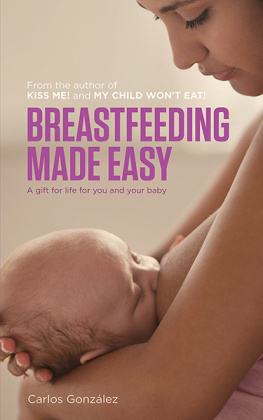This book is dedicated to mymother Sarah who helped me through my own challenges with breastfeeding.
Chapter 1- The Advantages of Breastfeeding for Mother and Baby
Itis strongly recommended by the American College of Obstetricians andGynecologists as well as the American Academy of Pediatrics that a motherbreastfeed her baby. Making a decision about breastfeeding your child can be avery personal matter that elicits strong opinions from others. It is importantto realize that you and your child are unique, and the decision is completelyup to you. Here is some information about the benefits involved withbreastfeeding.

Advantagesto the Baby
Idealnutrition is provided to the infant through the breast milk of the mother. Itis a nutritious mix of protein, vitamins, and fat. Those are the three thingsthat your baby needs to grow. Breast milk is more easily digested than theformula that is available. Breast milk also contains antibodies to help yourchild fight off bacteria and viruses. Breastfeeding can reduce your childsrisk of developing allergies and asthma. It has been proven that children fedwith breast milk only during the first six months had fewer ear infections,respiratory ailments, and bouts of diarrhea. They also end up having fewer hospitalizationsand doctor trips.
MoreAdvantages of the Baby
Beyondbeing physically healthy for your child, breast milk has also been linked toreceiving higher IQ scores later on in childhood. The closeness, skin touching,and eye contact all aid in giving your baby a feeling of security. A child thatis breastfed is also more likely to gain the correct amount of weight insteadof becoming overweight. The American Academy of Pediatrics has stated thatbreastfeeding plays a part in preventing SIDS, or Sudden Infant Death Syndrome.It has also been rumored to decrease the risk of diabetes, obesity, and evencertain kinds of cancer. There is more research is needed to confirm this.
Benefitsto the Child Later in Life
Ifa child is breastfed when young, more benefits become apparent later in time.An infant that is breastfed longer will have fewer cavities throughout theirlife. Studies have also shown that a child that gets breast-fed is less likelyto become obese later in life. Formula feeding, on the other hand, has beenlinked to between a 20 and 30 percent chance of the child becoming obese laterin life.
DecreasedRisks
Achild that is only breast-fed for the first three months of life is less likelyto develop juvenile diabetes than those that are fed formula. It is alsothought to lessen the risk of cancer in children under 15. A child fed withformula is eight times more likely to develop cancer. Studies have also shownthat those who are breast fed have a lower blood pressure than those fed withformula. Heart disease is also less likely.
PsychologicalAffects
Thereis a large amount of evidence that suggests breast-fed children end up withfewer psychological, learning, and behavioral problems as they get older. Theyalso show that the cognitive development is increased among those that arebreast fed. It has also been found that children that were breast-fed aregenerally more mature, secure, and assertive as they develop.
Advantagesof the Mother
Forthose trying to get rid of some baby fat, breastfeeding burns extra calories.It is actually proven to help a mother lose her pregnancy weight faster. Whenbreastfeeding the mother releases a hormone called oxytocin; this helps theuterus go back to the size it was prior to the pregnancy. It also helps to reducebleeding of the uterus after birth. A huge benefit to the mother is thatbreastfeeding lowers your risk of ovarian and breast cancer. It is also thoughtto reduce the risk of osteoporosis.
MoreBenefits to the Mother
Beyondthose benefits, a mother that breastfeeds ends up saving money. They do nothave to buy formula or bottles. It saves time as well. Instead of spending thetime preparing a bottle, the mother is ready to go. This also provides aregular time where the mother can relax quietly with her child. This helps toform a strong emotional bond.
Whatto Expect
Duringthe first few days after birth, the breasts produce the perfect first milk.This thick, yellowish liquid is called colostrum. Colostrum is perfect formeeting your childs nutritional needs as well as helping the newbornsdigestive track mature. This gets it ready to digest real breast milk.
FirstFew Days
Duringthe first three to five days of a babys life, most lose a little bit ofweight. This is completely unrelated to the breastfeeding. Your babys feedingneeds and your mild production are correlated. As your child starts eatingmore, you will produce more to make up for it. Most experts recommendbreastfeeding only for the first six months of a babys life. If you try to supplementthe babys diet with formula, it is likely that your production of milk will godown.
Signs
Thereare three things you should keep in mind while you are breastfeeding. First, beaware of the signs that your baby shows you to tell you that they are hungry.During the first two weeks, a mother may nurse between eight and twelve timesin a day. Signs to watch out for are the babys hands moving towards the mouth.You will also hear sucking noises or maybe see mouth movement. They can alsotry to move toward your breasts. Try to avoid waiting until your baby is cryingto feed. Crying is a sign of frustration from being too hungry.
Patience
Youmust learn to be patient with your child at feeding time. Breastfeed for aslong they wish. Do not rush your child through their meal. It is normal for ababy to breastfeed for between ten and twenty minutes.
Comfort
Beingcomfortable is also important at feeding time. When comfortable, you are morerelaxed. When relaxing during breastfeeding, the milk becomes more likely toflow. Use pillows to support your head, neck, and arms. A footrest can be usedto support your feet and legs while you breastfeed as well.
Nowthat you have seen all of the benefits that breast milk can have on both themother and the child, maybe you will have an easier time making your finaldecision. Both you and your child can enjoy the benefits associated withbreast-feeding.









